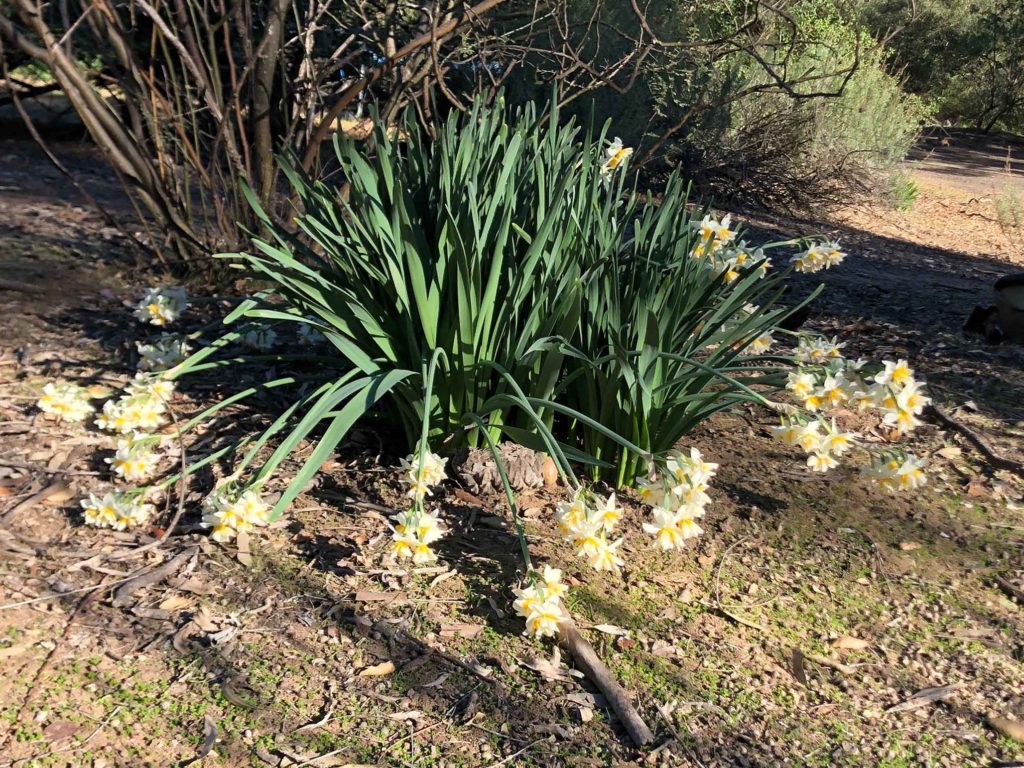Out with the old, in with the new? Uh, not so fast—at least not with everything. Even though our old Model A truck had gone through the Cedar Fire, my dad insisted that he was going to get it running again. I had serious doubts about that. I just wanted to use it as a planter for a bed of beautiful flowers. But I rounded up a couple of friends to help him move it further up the canyon where he wanted it—where over the years it rusted and fell apart even more than it was. He never did get around to fixing it.
Almost two decades later, I paid some guys with a trailer to bring it back down here to its next resting place: as yard art—backed into the bushes down by the gate. This whole process feels similar to our own aging. If we’re lucky to live long enough, we, ourselves, must make choices about how we adapt to our changing circumstances. Some resign to the recliner and take an increasing number of pharmaceutical drugs; a few push forward while attempting to exercise more than what might be good for them; others continuously adjust to their unpredictable situations and try to make do… I sometimes wonder how much fight is actually good for us.
I suppose I’m a little like the old Model A truck, repurposing myself as I go along—but probably still working too hard. Members of our generation may indeed be fading, but I do think we still have ideas to contribute as our younger brothers and sisters take over. They’ve grown up in the age of technology and can probably assess some things better than us. We can offer advice, stemming from simply living more years than them, as long as it doesn’t come with the outdated notion: Well, it’s always been done that way, therefore it’s tried and true.
But, as with our evolving physical bodies, the world must also address continuous change. Everything effects everything. For every action there is a reaction whether or not we can see it with our own eyes or experience it in our own lifetimes. Overpopulation, pollution, rising sea levels… Some of our current practices are not sustainable in the long run.
I personally love a lot of the old things like Model A’s, World War II airplanes (they fascinate me), antiques, horse and buggy stuff… But each of these things has had to take a back seat to new developments which ease burdens as the population grows. And sadly, I believe the era of each and every one of us owning our own car and going wherever we want to go, whenever we want to go, isn’t going to work forever. Rising gas prices curb some of this naturally. Yes, our cars are still necessary, but perhaps we should each start looking toward practices that can help solve some of our current problems, yet not add more toxic fallout to our future. Let’s try to be forward thinking about this.
My family has lived in San Diego County for seven generations and I’m a native Ramonan. I was here when the first stop light came to town, the first chain restaurant, the change from cement to asphalt roads, the widening and rewidening of the highway… It’s this last item that does not sit right with me—for the sake of our community or the environment.
Folks want to go faster and faster and get impatient and rude when they can’t. It’s no wonder so many accidents happen on that road. Perhaps the time has come to address the issue with forward thinking. Much of the rest of the developed world is light years ahead of us on this. Instead of widening the highway again and again, run a light rail line down the center (or along the side) that connects to other communities. We could still choose to drive our beloved cars on days we need to, but the transit system could serve us well.
Yes, this would be expensive, but everything costs a lot. Instead of putting a bigger and bigger bandage on this growing problem, let’s take care of the larger issue and move forward. Anything new takes time to adjust to. Can’t we at least start now?
Chi Varnado has four recently published books. The Old House in the Country, women’s fiction; and three YA novels in The Dance Centre Presents series. Her memoir, A CANYON TRILOGY: Life Before, During and After the Cedar Fire, and her children’s book, The Tale of Broken Tail, are also available on www.amazon.com. Her collection of essays, Quail Mutterings, can be found on www.chivarnado.com or www.dancecentrepresents.com. You can follow her on Instagram or on www.Facebook.com/dancecentrepresents.



